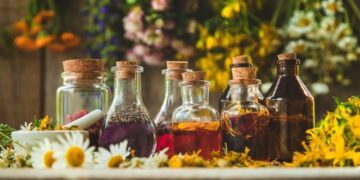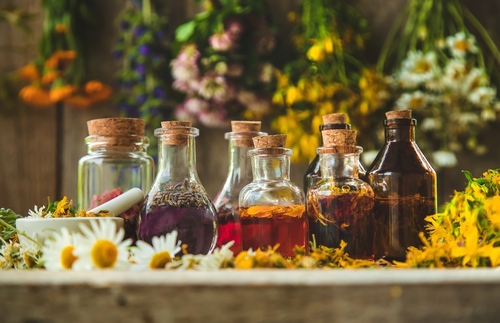The Art of Herbal Making
There’s a quiet reverence in preparing herbs by hand. Crushing leaves between fingers, pouring oils over petals, stirring slowly as steam rises—it’s not unlike cooking, but with a different kind of nourishment in mind. These practices aren’t new. They’ve been passed from kitchen to kitchen, whispered in gardens, scribbled in old journals, and stored in apothecary jars along sun-warmed windowsills.
Learning to work with herbs in various preparations is not only a practical skill—it’s a way of weaving yourself into an ancient rhythm. You begin to see plants not just as beautiful or fragrant, but as living medicines. With time, they teach you how to listen more closely, move more slowly, and trust your hands.
Among the many methods, tinctures, salves, and infusions are some of the most foundational. Each offers a different way to draw out a plant’s healing properties and preserve its strength.
Ad Spot #1
(Insert your first promotional element here.)
Infusions: Drawing the Plant’s Heart
An infusion is the simplest and perhaps most intimate way to work with herbs—much like making tea, but with deeper intention.
This method involves pouring hot water over dried or fresh herbs and letting them steep. The process draws out the plant’s water-soluble properties: vitamins, volatile oils, flavonoids, and other nourishing compounds.
Best for: Leaves, flowers, soft stems
Examples: Chamomile, nettle, lemon balm, oatstraw, linden
How to Make a Strong Herbal Infusion:
-
Use 1 tablespoon of dried herb (or 2 tablespoons fresh) per cup of hot water.
-
Pour boiling water over the herb in a jar or heat-safe vessel.
-
Cover immediately to trap volatile oils.
-
Let steep 20 minutes to several hours, depending on the herb.
-
Strain and sip, or store in the fridge for up to 24 hours.
For more nourishing herbs like nettle or oatstraw, steeping overnight draws out minerals in a way that feels like being filled up from the inside.
Tinctures: Potent Drops of Herbal Strength
Tinctures are concentrated herbal extracts made with alcohol. They’re strong, shelf-stable, and easy to take in small doses—just a few drops under the tongue or in a bit of water or tea.
In folk practice, tinctures were made when preserving plants was necessary—when the blooms came fast and furious in spring, and you needed to hold their essence for winter’s leaner months.
Best for: Roots, barks, seeds, and herbs with strong medicinal compounds
Examples: Echinacea, valerian root, ashwagandha, milk thistle
How to Make a Simple Folk Tincture:
-
Fill a glass jar ⅓ to ½ full with dried herb (or ¾ full with fresh).
-
Cover completely with high-proof alcohol (vodka or brandy, at least 40%).
-
Stir well and seal tightly with a lid.
-
Label the jar with the herb, date, and alcohol used.
-
Store in a cool, dark place for 4–6 weeks. Shake it daily.
-
Strain through cheesecloth into dark glass bottles.
Tinctures keep for years, and their compact size makes them easy to carry and dose. A small bottle of tulsi or motherwort tincture can bring calm or courage in the middle of a storm.
Salves: Medicine in a Jar
Salves are thick, oil-based preparations used externally to soothe, heal, or protect the skin. They begin with a herbal oil—made by infusing herbs in a carrier oil like olive or jojoba—and are then thickened with beeswax to create a balm-like consistency.
From healing cuts and scrapes to easing sore muscles or protecting chapped hands, salves are a deeply grounding way to bring herbs into the body through touch.
Best for: Skin-healing herbs and anti-inflammatories
Examples: Calendula, comfrey, plantain, arnica, yarrow
How to Make a Basic Herbal Salve:
-
Start with an oil infusion.
-
Fill a clean jar with dried herb (not fresh—moisture causes spoilage).
-
Cover completely with oil.
-
Let sit in a warm spot for 2–4 weeks, shaking daily, or use a gentle double-boiler method for quicker infusion (1–3 hours on low heat).
-
-
Strain the oil.
-
Use cheesecloth to separate the herb from the oil.
-
-
Melt together:
-
1 cup infused oil
-
¼ cup beeswax (adjust for softness)
-
Optional: a few drops of essential oil or vitamin E
-
-
Pour into jars or tins.
-
Let cool and solidify before sealing.
-
A salve made with calendula and lavender, for example, becomes a balm for dry hands, insect bites, or sun-kissed skin. There’s something ancient and healing in rubbing it into the palms, like a blessing passed from leaf to skin.
Ad Spot #2
(Insert your second promotional element here.)
Honoring the Craft
As with any traditional medicine, herbal preparations are not one-size-fits-all. Take your time. Use clean tools. Label everything carefully. Keep a journal, if you like—note which plants you used, how long they infused, how you felt after using them.
And always listen—to your body, to the seasons, to the plants themselves. Some herbs are gentle enough for everyday use, while others carry more intensity. Learn their personalities. A warming root like ginger might stir the system in winter but feel too stimulating in summer. A calming herb like valerian might soothe one person and unsettle another.
Start with what calls to you. Begin small. Let your relationship with each herb unfold like a conversation, slow and meaningful.
A Living Tradition
Herbal preparations are not only tools of healing—they’re gestures of care. When you make a tincture or salve or strong infusion, you’re stepping into a lineage of hands that have done the same. You’re saying, I trust the earth to support me. And perhaps more importantly: I trust myself to receive it.
In learning these simple techniques, you’re not just gaining skill. You’re reclaiming a relationship—with the land, with your health, with the rhythm of slowness that plants teach so well.
A jar of golden oil, a bottle of bitter tincture, a cup of warm infusion—each one holds a piece of the plant’s story and becomes part of your own.



























